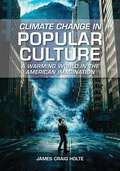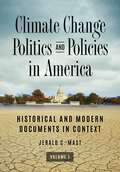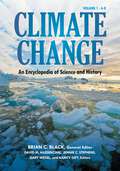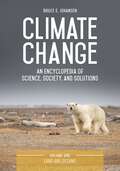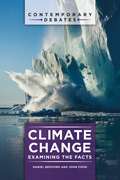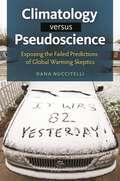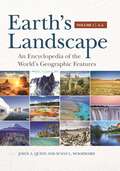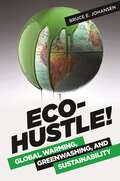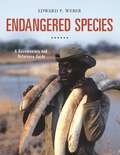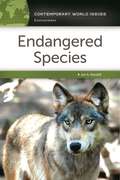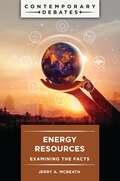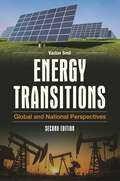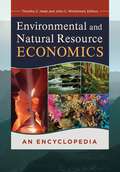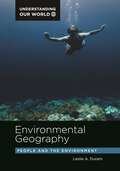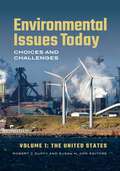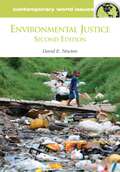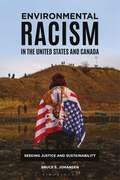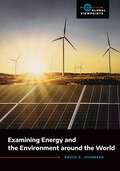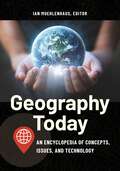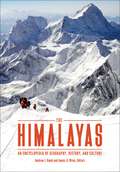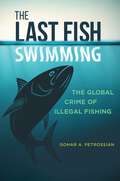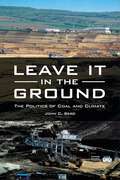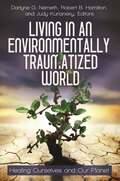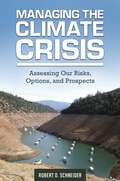- Table View
- List View
Climate Change in Popular Culture: A Warming World in the American Imagination
by James Craig HolteAn invaluable resource for general readers investigating climate change, this book examines the impact of climate change on popular culture and analyzes how writers and directors treat the disasters caused by climate change in their novels and films.Climate Change in Popular Culture: A Warming World in the American Imagination is the first study that includes analyses of both fiction and popular nonfiction works devoted to climate change. In addition, the book examines a number of classic works from the perspective of the growing field of climate change literature and includes a brief history of climate change science as well basic scientific definitions, all intended for general readers.The text provides an introduction to the science, politics, and economics of climate change. It also includes both historical overviews and potential probable futures projected by leading climate scientists and environmental writers. In addition, the text looks at how such creative writers and directors as Margaret Atwood, John Steinbeck, Paulo Bacigalupi, Kim Stanley Robinson, T. C. Boyle, Michael Crichton, and Octavia Butler, among others, have used the disasters caused by climate change in their work.
Climate Change Politics and Policies in America [2 volumes]: Historical and Modern Documents in Context [2 volumes]
by Jerald C. MastThis collection of primary sources, illuminated by extensive contextual analysis, provides a comprehensive and balanced survey of the evolution of global climate change policies and politics in the United States.This extensive collection of primary documents examines the history of climate science; various policy prescriptions for addressing the effects of climate change; political fault lines with respect to international efforts to address global warming; claims regarding the influence of industry groups and environmental "radicals" on climate policy and science; and the impact of climate change on other policy areas such as public health, energy, economic development, and wilderness conservation. The set includes excerpts from important scientific papers and government reports, political speeches from presidents and other influential lawmakers, perspectives from environmental activists and conservative think-tanks, editorial essays from leading media figures, provisions of major laws, and more. Together, these documents provide a broad range of perspectives, from scientific fields as well as from political and ideological standpoints that have emerged in response to the debate surrounding climate change. They offer readers a greater understanding of the arguments not only of lawmakers, activists, and scientists leading efforts to fight, mitigate, and adapt to climate change but also of those skeptical of climate change.
Climate Change [4 volumes]: An Encyclopedia of Science and History [4 volumes]
by Brian C. Black, David M. Hassenzahl, Jennie C. Stephens, Gary Weisel, and Nancy GiftThis book provides a holistic consideration of climate change that goes beyond pure science, fleshing out the discussion by considering cultural, historical, and policy-driven aspects of this important issue.Climate change is a controversial topic that promises to reframe rudimentary ideas about our world and how we will live in it. The articles in Climate Change: An Encyclopedia of Science and History are designed to inform readers' decision making through the insight of scholars from around the world, each of whom brings a unique approach to this topic. The work goes beyond pure science to consider other important factors, weighing the cultural, historical, and policy-driven contributors to this issue. In addition, the book explores the ideas that have converged and evolved in order to clarify our current predicament. By considering climate change in this holistic fashion, this reference collection will prepare readers to consider the issue from every angle. Each article in the work is suitable for general readers, particularly students in high school and college, and is intended to inform and educate anyone about climate change, providing valuable information regarding the stages of mitigation and adaptation that are occurring all around us.
Climate Change [3 volumes]: An Encyclopedia of Science, Society, and Solutions [3 volumes]
by Bruce E. JohansenThis three-volume set presents entries and primary sources that will impress on readers that what we do—or don't do—today regarding climate change will dramatically influence what life on this planet will be like for untold numbers of generations.How are the behaviors of birds, butterflies, and other migratory animals connected to climate change? What does the term "thermal inertia" mean, and what does this geophysical effect have on predicting what the planet's future will be like? What is the context for the effects we are seeing on various forms of animal life, from migrating birds to polar bears to mosquitoes that transmit Zika and other diseases?Climate Change: An Encyclopedia of Science, Society, and Solutions combines entries describing Earth's variable climatic history, references to scientific literature, weather record data, and selected primary documents to present readers with a comprehensive account of global warming's effects worldwide. By examining verifiable, quantitative information such as the frequency and intensity of hurricanes and changes in the hydrological cycle, as well as clear patterns and trends of alternating droughts and deluges and wildfires, melting ice, and rising seas, readers will be able to understand why scientists are so concerned about the future of our climate. Researchers will benefit from detailed explanations of scientific topics such as thermal inertia, feedbacks, and tipping points; and receive invaluable context on the role of energy use in climate change, including automobiles and air travel. Readers will learn about the role of China in the current global climate and in the future; the widespread effects of climate change on agriculture; and how indigenous peoples' lives are being impacted, from drought and the Navajos to hunters' lives in the Arctic. The work concludes with thought-provoking debates regarding potential solutions, from wind power and solar power to geo-engineering.
Climate Change: Examining the Facts (Contemporary Debates)
by Daniel Bedford John CookClimate change is one of the most controversial and misunderstood issues of the 21st century. This book provides a clear understanding of the issue by presenting scientific facts to refute falsehoods and misinformation—and to confirm the validity of other assertions.Is public understanding of global warming suffering from politically biased news coverage? Is it true that the global scientific community has not reached a consensus on whether humans are causing climate change? This important book addresses these questions and many more about global warming, identifying common claims about climate change and using quantifiable, evidence-based information to examine their veracity.The authors of this work examine 35 specific claims that have been made about global climate change by believers and skeptics. These assertions—some true, some false—will guide readers to a much deeper understanding of the extent of climate change; whether any climate change that is taking place is human-caused; whether climate change is likely to be a serious problem in the future; whether scientists agree on the fundamentals of climate change; and whether climate change impacts can be mitigated. Examples of specific issues that are scrutinized and explained in the book include: trends in the extent and condition of Arctic and Antarctic Sea ice packs, the accuracy of climate forecasting models, whether extreme weather events are increasing as a result of climate change, and the benefits and drawbacks of various schemes to limit greenhouse gas emissions.
Climatology versus Pseudoscience: Exposing the Failed Predictions of Global Warming Skeptics
by Dana NuccitelliThis book explains the science of climate change in plain language and shows that the 2 to 4 percent of climate scientists who are skeptical that humans are the main cause of global warming are a fringe minority—and have a well-established history of being wrong.Although some politicians, pundits, and members of the public do not believe it, global warming predictions by mainstream climate scientists have been remarkably accurate while those made by climate deniers have not. And if mainstream global warming predictions continue to prove correct, the window of opportunity to prevent a climate catastrophe is quickly closing. This book is the first to illustrate the accuracy—and inaccuracy—of global warming predictions made by mainstream climate scientists and by climate contrarians from the 1970s to the present day. Written in simple, non-technical language that provides an accessible explanation of key climate science concepts, the book will appeal to general audiences without previous knowledge about climate science.Author Dana Nuccitelli, an environmental scientist and risk assessor, discusses some key climate discoveries dating back to the 19th century and debunks myths such as the idea that climate scientists and climate models have grossly over-predicted global warming. He addresses recent findings of a 97-percent consensus in the peer-reviewed scientific literature that humans are causing global warming—a nearly unanimous agreement that formed in the early 1990s and has grown through the present day. Nuccitelli also discusses what the future climate might look like if current trends continue unabated, and what we as a global society need to do to prevent a climate catastrophe.
Encyclopedia of Cultivated Plants [3 volumes]: From Acacia to Zinnia [3 volumes]
by Christopher CumoReaders of this expansive, three-volume encyclopedia will gain scientific, sociological, and demographic insight into the complex relationship between plants and humans across history.Comprising three volumes and approximately half a million words, this work is likely the most comprehensive reference of its kind, providing detailed information not only about specific plants and food crops such as barley, corn, potato, rice, and wheat, but also interdisciplinary content that draws on the natural sciences, social sciences, and humanities. The entries underscore the fascination that humans have long held for plants, identifies the myriad reasons why much of life on earth would be impossible without plants, and points out the intertwined relationship of plants and humans—and how delicate this balance can be. While the majority of the content is dedicated to the food plants that are essential to human existence, material on ornamentals, fiber crops, pharmacological plants, and carnivorous plants is also included.
Earth's Landscape [2 volumes]: An Encyclopedia of the World's Geographic Features [2 volumes]
by Joyce A. Quinn Susan L. WoodwardThis unusual encyclopedia brings together in-depth information on more than 450 natural geographic features from around the world and offers an array of creative tools to promote critical thinking and classroom discussion.With Earth undergoing rapid environmental change, students and the general public alike should be knowledgeable about the world's geographic features. This authoritative, two-volume reference enables readers do just that. It describes continents and oceans; individual mountains, islands, caves, and rivers; and ecological entities such as wildlife refuges and national parks. Each entry provides a geographic overview of the feature's significance, location, description, geologic history, biota, protected areas, and environmental issues. But the coverage goes even deeper so that entries also discuss the cultural importance of each natural place, covering everything from indigenous beliefs to traditional folklore to contemporary legends.The encyclopedia stands apart from other works not only in the depth of its coverage but also in its range. It discusses lesser known as well as prominent geographical features and offers critical thinking aids that will help students see how the natural world relates to their daily lives. Teaching and learning tools include an appendix called "Opposing Viewpoints" that allows students to understand landforms involved in current conflicts and disputes as well as an "Activities/Discussion Questions" appendix.
Eco-Hustle!: Global Warming, Greenwashing, and Sustainability
by Bruce E. JohansenHow many of our efforts to save the environment are effective? Learn how our system is simply masking the symptoms of global warming.Climate change is more than just a buzzword. It is a reality that society and industry have failed to deal with effectively. "Greenwashing," a term that author Bruce E. Johansen defines as the "environmental sleight of hand" performed by technology and advertising, has us convinced that certain "green" practices are sustainable. In his book, Johansen examines the sanctioned activities and practices commonly touted as environmentally responsible and points out their failings. He explains why the global climate change problem is more urgent than many people think, and provides real-world examples of companies that are taking measures with genuine benefits to the environment.Presenting information relevant to every inhabitant of earth and that environmentalists, climate scientists, and students and educators in environmental studies will find essential reading, this book brings questions about legislation and economics to the forefront and asks whether today's system can support a true effort at sustainable living. It presents honest—and what some readers may find surprising—answers to inquiries into what is really "good for the environment," such as why corn ethanol may be worse for the atmosphere than oil and why coal capture and sequestration may be the worst "green" idea yet.
Endangered Species: A Documentary and Reference Guide (Documentary and Reference Guides)
by Edward P. WeberThis book uses primary documents as a lens through which to examine historical and present-day efforts to protect endangered species in the United States and around the world.In this thought-provoking work, author Edward P. Weber examines the values, policies, challenges, and approaches to endangered species conservation over the past 200 years. Using primary source documents and in-depth analysis of the issues, the reference tracks the evolution of species protection and conservation in the United States, and offers a brief look at global programs in the United States and other parts of the world. The book surveys how different countries are faring in protecting their plant and animal life, and considers which guidelines and programs hold the most promise for success in the future. Chapters compare and contrast past and present attitudes regarding endangered species and extinction and identify the influence of major organizations and individuals central to the debate over endangered species. Judiciously selected primary documents also explore the impact of species endangerment and loss on natural ecosystems—and ultimately, on humankind itself.
Endangered Species: A Reference Handbook (Contemporary World Issues)
by Jan A. RandallA detailed exploration of the variety of threats that endangered species are facing around the world, whether they are due to human impact or so-called natural causes.Endangered species is a more complex issue and problem than it may seem on the surface. What species are endangered, and what is causing them to become vulnerable to population decline? How can essential industries such as farming, housing development, and manufacturing continue to thrive without harming flora and fauna that are protected? Are current efforts adequate or should more be done to protect endangered species? And who should be responsible for the substantial costs of working to save endangered species?Endangered Species: A Reference Handbook begins with an introduction that addresses major threats and extinctions in history, discusses the geographical and cultural contexts in which these incidents happened, highlights other key moments along the endangered species timeline, and clearly shows why the topic of endangered species matters. The following sections examine an unbiased synthesis of classic and contemporary studies that inform the issue of endangered species and outline the most controversial events related to endangered species and the actions that have been taken to address them. The book also presents perspective essays by scholars, activists, and other experts to provide diverse informed opinions on the issue of endangered species and includes a data and documents chapter that applies research finding to provide answers to questions like what species are most likely to become endangered in the future and which practices have historically been the most effective at protecting vulnerable species.
Energy Resources: Examining the Facts (Contemporary Debates)
by Jerry A. McBeathEnergy Resources: Examining the Facts provides an authoritative, comprehensive overview of economic, political, and environmental drivers of America's energy picture, from trends in the production and consumption of fossil fuels and renewables to the state of the national energy grid.Energy Resources: Examining the Facts is part of a series that uses evidence-based documentation to examine the veracity of claims and beliefs about high-profile issues in American culture and politics. Each book in the Contemporary Debates series is intended to puncture rather than perpetuate myths that diminish our understanding of important policies and positions; to provide needed context for misleading statements and claims; and to confirm the factual accuracy of other assertions.This installment in the series provides a comprehensive overview of all energy resources used in the United States, including fossil fuels (oil, gas, coal), nuclear power, hydropower, other major renewables (solar and wind), and even smaller energy sources, such as wood products (biomass), ethanol, plant-based fluids/gases, and geothermal, that have meaningful potential for future growth. The framework of laws and regulations in which energy resources are developed, produced, and overseen is described, as are the ways in which economic development powered by different energy resources is impacting people and ecosystems in the United States and around the world.
Energy Transitions: Global and National Perspectives
by Vaclav SmilThis book provides a detailed, global examination of energy transitions, supplying a long-term historical perspective, an up-to-date assessment of recent and near-term advances in energy production technology and implementation, and an explanation of why efforts to limit global warming and to shift away from fossil fuels have been gradual.Based on the best international and national statistical sources, the second edition of Energy Transitions: Global and National Perspectives supplies an in-depth evaluation of how economies and nations around the world are striving to move away from traditional energy sources, the unfolding decarbonization process, and problems with intermittent energies and national transition plans. It supplies readers with a clear introduction to the basic properties of energy systems and key concepts of their appraisal, puts energy transition patterns in long-term historical perspective, and looks at the energy transition in eight of the world's leading economies. The last chapters focus on the advances in the decarbonization of the global energy supply and consider how the energy transition will continue in the coming decades.This fully updated and substantially expanded edition addresses the many new developments affecting energy supply, such as the recent expansion of hydraulic fracturing, oil price fluctuations, the Fukushima nuclear power plant catastrophe, advances in solar and wind generation, adoption of combined cycle gas turbines, and increased availability of electric cars. The coverage highlights the differences in the pace of transitions in various countries, thereby providing a complete and accurate picture of the current state of energy development in different parts of the world. The book serves as an invaluable resource for students as well as for anyone interested in a realistic appraisal of the current state of energy transitions in various nations and regions and the likely future development of the global energy supply.
Environmental and Natural Resource Economics: An Encyclopedia
by Timothy C. Haab and John C. WhiteheadAccessible to students and practitioners without an advanced degree in environmental economics, this essential reference work pinpoints the role of the economy in both creating and solving many of the world's most pressing environmental challenges.Given the number and scope of environmental problems we face today, everyone from high school students to policy makers to concerned citizens should understand how the economy works and grasp how meltdowns—both economic and environmental in nature—can be avoided. Environmental and Natural Resource Economics: An Encyclopedia offers the critical information needed to comprehend these complex issues. The entries cover topics in a manner parallel to how environmental economics is commonly taught, addressing basic concepts, environmental policy, natural resource economics, market failure, exhaustible and renewable resources, benefit-cost analysis, and applied welfare economics. Additionally, the book includes entries on key concepts of economics, movements, events, organizations, important individuals, and research areas relevant to the study of environmental and natural resource economics. This work stands alone as the only title currently offering such a breadth of coverage and level of detail written specifically for readers without specialized knowledge of environmental economics.
Environmental Geography: People and the Environment (Understanding Our World)
by Leslie A. DuramExplores the complex relationship humans have with the environment. It is one of both responsibility—including the sustainable or unsustainable management of natural resources—and emotion, like the elation gleaned from a beautiful landscape or the devastation experienced from a natural disaster.Human-induced damage to the environment has widespread consequences for Earth and its inhabitants that have already included sea level rise, increased wildlife extinctions, heatwaves, droughts, intensified air pollution, and water shortages.This book provides comprehensive coverage of the complex interactions between people and the environment. It presents three clear, honest, and down-to-earth essays that cover the devastating impact humans have on the environment; the equally devastating impact the environment has on humans at times; and the positive impact that increasing awareness of our effect on the planet is having on the movement to create a more sustainable future. In addition, in-depth entries on 60 key environmental geography terms, such as deforestation, ecotourism, and environmental justice, provide a deeper dive into the topic; 15 real-world case studies on topics like the Great Pacific Garbage Patch and the Great Green Wall of Africa illustrate geography in action; and 10 brief spotlights from around the world draw the reader in with relevant facts.
Environmental Issues Today [2 volumes]: Choices and Challenges [2 volumes]
by Robert J. Duffy and Susan M.This two-volume set provides an authoritative overview of the major environmental issues of the 21st century, with a special focus on current challenges, trends, and policy choices.This set provides an up-to-date, comprehensive, and focused resource for understanding the nature and scope of environmental challenges facing the United States and the world in the 21st century, as well as options for meeting those challenges. Volume One covers environmental trends and challenges within the United States, while Volume Two illuminates environmental issues and choices around the world. Issues covered in both volumes include vital topics such as climate change, air and water pollution, natural resource and species protection, and agricultural/industrial impacts on the environment and public health. For all topics, the authors—scholars and experts hailing from a wide range of environmental and policy fields—detail a range of political, social, and economic options for the future and explain why the issue in question is important for society and people as well as the natural world.
Environmental Justice: A Reference Handbook (Contemporary World Issues)
by David E. NewtonEnvironmental Justice: A Reference Handbook, Second Edition offers a current overview of the environmental inequities faced by poor and minority communities and the development of the grassroots movement working to address them.Building on the original edition's focus on the link between social inequalities and the uneven distribution of environmental hazards in the air, water, and soil, Environmental Justice: A Reference Handbook, Second Edition presents a contemporary look at the convergence of the environmental movement and civil rights activism.Environmental Justice, Second Edition follows the rise and maturation of the movement focused on environmental racism, describes solutions that have been implemented, and examines issues that remain unresolved. The book offers a wealth of new data and information, particularly in its expanded coverage of environmental disparities in developing countries and its rich bibliography of print and online resources.
Environmental Racism in the United States and Canada: Seeking Justice and Sustainability
by Bruce E. JohansenFrom Flint, Michigan, to Standing Rock, North Dakota, minorities have found themselves losing the battle for clean resources and a healthy environment. This book provides a modern history of such environmental injustices in the United States and Canada.From the 19th-century extermination of the buffalo in the American West to Alaska's Project Chariot (a Cold War initiative that planned to use atomic bombs to blast out a harbor on Eskimo land) to the struggle for recovery and justice in Puerto Rico following Hurricane Maria in 2017, this book provides readers with an enhanced understanding of how poor and minority people are affected by natural and manmade environmental crises.Written for students as well as the general reader with an interest in social justice and environmental issues, this book traces the relationship between environmental discrimination, race, and class through a comprehensive case history of environmental injustices. Environmental Racism in the United States and Canada: Seeking Justice and Sustainability includes 50 such case studies that range from local to national to international crises.
Examining Energy and the Environment around the World (Global Viewpoints)
by Bruce E. JohansenThis volume addresses ten issues pertaining to energy and the environment, such as climate change, fossil fuels, endangered species, and renewable energy, and examines how these issues are affecting countries around the world.In the industrial age, first powered by coal and then more often by oil, environmental degradation nearly inevitably followed resource exploitation and energy production. This book examines environmental issues in specific countries around the world as well as solutions some of these countries have discovered in order to help save the environment.This volume includes 10 chapters, each addressing a specific issue relating to energy and the environment as it pertains to a variety of countries, including toxic chemicals, pollution, deforestation, and climate change. Each chapter begins with an introduction to the issue. Following the chapter introduction, each chapter highlights that issue in eight countries and provides historic perspective. This work provides an overview for high school students and college students at the undergraduate level on 10 important topics that address matters relating to energy and the environment in the 21st century.
Geography Today: An Encyclopedia of Concepts, Issues, and Technology
by Ian MuehlenhausGeography Today provides a thoughtful and thorough introduction to the study of geography—from maps and technology to the study of different cultures, political systems, and economies, and an investigation of plate tectonics and climate systems.Geography Today: An Encyclopedia of Concepts, Issues, and Technology approaches the study of geography by concept, in contrast to most other works, which are organized by world region. Geography curriculums have been moving away from teaching the topic on a regional basis and toward teaching it through broader concepts. This is modeled by the National Geography Standards, the National Council for Geographic Education's Roadmap for 21st Century Geography Education, Texas Essential Knowledge and Skills Resource System, and ABC-CLIO's own geography advisory board, comprised of high school geography teachers from across the United States. By introducing geography concepts, Geography Today sets the foundation for readers to understand why certain geographies may be the way they are. It further helps high school geography students to apply concepts to different contexts with 101 geography terms, themes, and concepts for quick-reference research and study.
The Himalayas: An Encyclopedia of Geography, History, and Culture
by Andrew J. Hund and James A. WrenA thorough and detailed resource that describes the history, culture, and geography of the Himalayan region, providing an indispensable reference work to both general readers and seasoned scholars in the field.The Himalayas: An Encyclopedia of Geography, History, and Culture serves as a convenient and authoritative reference for anyone exploring the region and seeking to better understand the history, events, peoples, and geopolitical details of this unique area of the world. It explores the geography and details of the demographics, discusses relevant historical events, and addresses socioeconomic movements, political intrigues and controversies, and cultural details as to give an overarching impression of the region as a coherent and cohesive whole. Readers will come away with a vastly heightened understanding of the geographical region we recognize as the Himalayas, and grasp the issues of geography, history, and culture that are central to contemporary understandings of the human culture in the region.The alphabetically arranged and succinct entries provide easy access to detailed, authoritative information. Additionally, sidebars throughout the book relate compelling facts that point readers to new and interesting avenues of exploration. The volume also includes a chronological overview of the region, ten primary source documents, and a comprehensive bibliography of supporting works.
The Last Fish Swimming: The Global Crime of Illegal Fishing (Global Crime and Justice)
by Gohar A. PetrossianThis book examines the global, local, and specific environmental factors that facilitate illegal fishing and proposes effective ways to reduce the opportunities and incentives that threaten the existence of the world's fish.Humans are deeply dependent on fishing—globally, fish comprise 15 percent of the protein intake for approximately 3 billion people, and 8 percent of the global population depends on the fishing industry as their livelihood. The global fishing industry is plagued by illegal fishing, however, and many highly commercial species, such as cod, tuna, orange roughy, and swordfish, are extremely vulnerable. Through criminological analysis, The Last Fish Swimming emphasizes the importance of looking at specific environmental factors that make illegal fishing possible. It examines such factors as proximity to known ports where illegally caught fish can be landed without inspection (i.e., ports of convenience), fisheries monitoring, control and surveillance efforts, formal surveillance, and resource attractiveness in 53 countries that altogether represent 96 percent of the world's fish catch. The book calls upon the global community to address the illegal depletion of the world's fish stock and other similar threats to the world's food supply and natural environment in order to ensure the sustainability of the planet's fish and continuation of the legal fishing industry for generations to come.
Leave It in the Ground: The Politics of Coal and Climate
by John C. BergEmploying scientific explanations and hard data, this book shows why coal is such a problem, how the pro-coal forces got to be so powerful, and how those forces might be defeated through political activism.Coal provided the energy to build modern civilization. This energy source raised standards of living, multiplied the earth's population, and enabled people in developed countries to enjoy leisure time. Today, we know that if we burn all the coal available, climate change will continue to increase. But the use of coal isn't purely an environmental issue; there are also political and economic forces at play. This book examines the politics and environmental impact of coal production and distribution, presenting a clear point of view—that we must shift away from coal use—backed by hard data and supplying specific prescriptions for opposing and regulating the coal industry.Author John C. Berg explains how ending the burning of coal (and of oil and natural gas) is a political problem rather than a technical one; explodes the "clean coal" myth, providing scientific documentation of how burning coal emits more greenhouse gases per unit of energy than any other fuel; and describes how controlling coal use in the United States will also serve to restore the possibility of a meaningful international climate agreement. Additionally, readers will understand the critical importance of activism—from local to international—in spurring government regulation to control the coal industry, which can only be defeated politically.
Living in an Environmentally Traumatized World: Healing Ourselves and Our Planet (Practical and Applied Psychology)
by Darlyne G. Nemeth Robert B. Hamilton Judy Kuriansky João Lucilio Ruegger de Albuquerque Gloria Alvernaz Mulcahy Robert A. Muller Donald F. Nemeth Anna T. Onishi Yasuo Onishi Alexander P. Steger L. Taighlor Whittington Susan ZelinskiThis book follows environmental changes—including those caused by human actions, as well as those resulting from natural circumstances—and provides a process to manage their impact on the future.Whenever environmental damages are caused by natural or human-made events, there are long-term effects for people. This eye-opening and unprecedented book explains the ongoing turmoil in the environment, while presenting ways to alleviate its effect on humankind's physical and mental health. Living in an Environmentally Traumatized World: Healing Ourselves and Our Planet discusses recent environmental events and examines the reasons why the resulting changes are inevitable. The authors assert that people experience six universal stages when they suffer from environmental trauma: shock, survivor mode, basic needs, awareness of loss, spin and fraud, and resolution. The book presents coping strategies for navigating negative ecological shifts, and provides a plan of action for responsibly managing our environment. Additionally, profiles of indigenous people who endure under environmental adversity provide real world examples of survival.
Managing the Climate Crisis: Assessing Our Risks, Options, and Prospects
by Robert O. SchneiderUsing a risk management approach to tease apart the complex issue of climate change, this book assesses the key vulnerabilities and redirects the discussion to present a comprehensive plan to overhaul our response to climate change.According to the 2014 U.S. Climate Report, temperatures might increase by 5 degrees even with aggressive strategies to reduce greenhouse gas emissions and could increase by as much as 10 degrees if emissions continue unabated. The report also predicts increases in extreme weather caused by global warming will continue. It is time to apply the lessons of sustainable disaster mitigation and hazard resilience to respond to the challenges posed by global warming, identify and assess the options we have for addressing the crisis, and create a practical plan for managing the problem.Unlike other books on climate change, this one uniquely applies a risk management approach to answer the question, "Considering what our policies look like now, what do we need to do next to mitigate climate change?" Robert O. Schneider, PhD, explains how the warming climate will affect everything from peak temperatures and weather extremes to infrastructure such as groundwater reservoirs, airports, and wastewater systems, making the dire nature of the crisis clear to readers in practical and personal terms. By enabling readers to understand the scientific and historical contexts of the climate crisis, the author makes a compelling case for the urgency of implementing a national climate policy to respond to the challenges posed by global warming.
